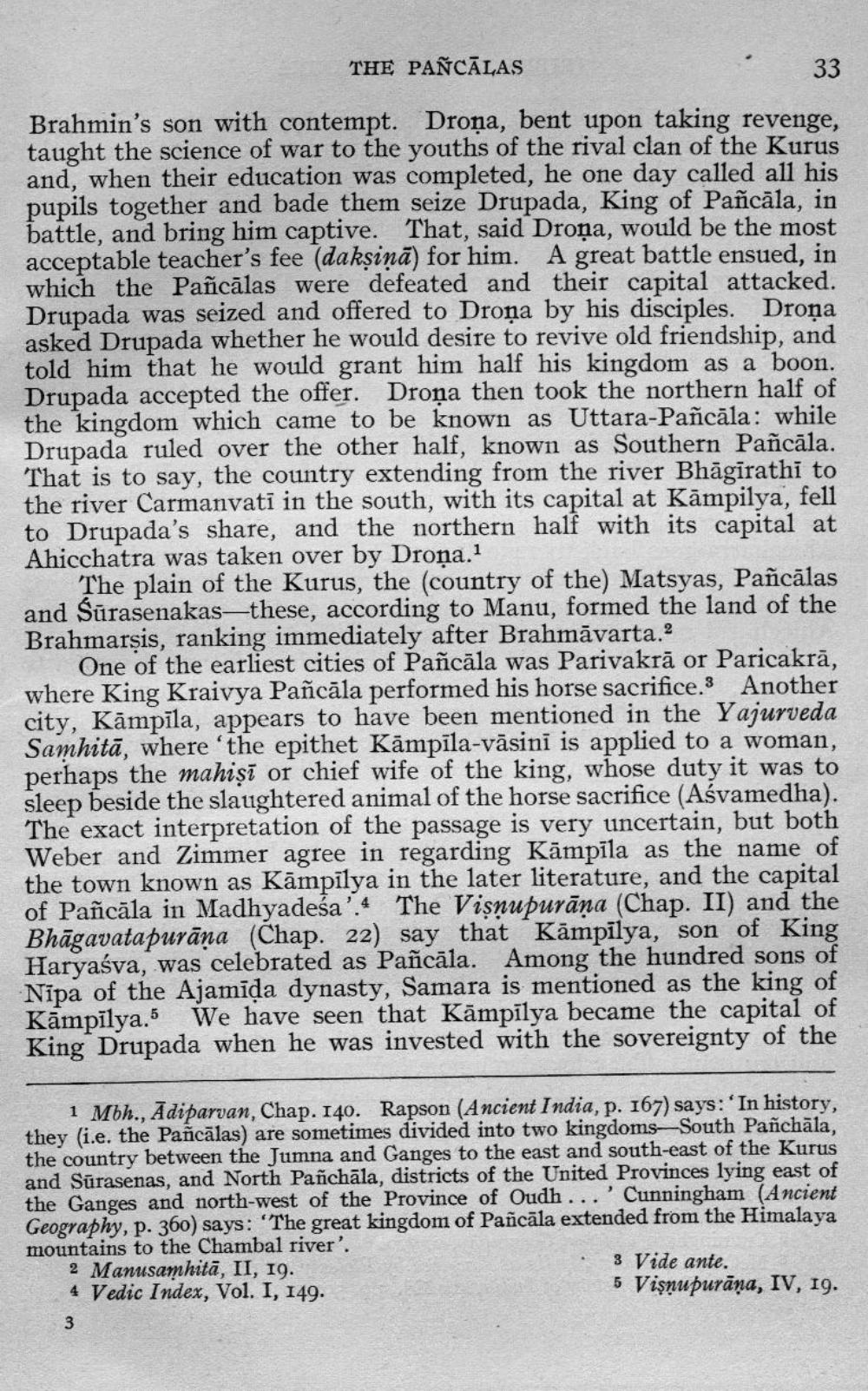________________
THE PAÑCĀLAS
33
Brahmin's son with contempt. Droņa, bent upon taking revenge, taught the science of war to the youths of the rival clan of the Kurus and, when their education was completed, he one day called all his pupils together and bade them seize Drupada, King of Pañcāla, in battle, and bring him captive. That, said Droņa, would be the most acceptable teacher's fee (daksinā) for him. A great battle ensued, in which the Pañcālas were defeated and their capital attacked. Drupada was seized and offered to Droņa by his disciples. Drona asked Drupada whether he would desire to revive old friendship, and told him that he would grant him half his kingdom as a boon. Drupada accepted the offer. Droņa then took the northern half of the kingdom which came to be known as Uttara-Pañcāla: while Drupada ruled over the other half, known as Southern Pañcāla. That is to say, the country extending from the river Bhāgīrathi to the river Carmanvati in the south, with its capital at Kāmpilya, fell to Drupada's share, and the northern half with its capital at Ahicchatra was taken over by Droņa.
The plain of the Kurus, the (country of the) Matsyas, Pañcālas and Sūrasenakas—these, according to Manu, formed the land of the Brahmarşis, ranking immediately after Brahmāvarta.2
One of the earliest cities of Pañcāla was Parivakrā or Paricakrā, where King Kraivya Pañcāla performed his horse sacrifice. Another city, Kāmpila, appears to have been mentioned in the Yajurveda Samhitā, where 'the epithet Kāmpīla-vāsini is applied to a woman, perhaps the mahișī or chief wife of the king, whose duty it was to sleep beside the slaughtered animal of the horse sacrifice (Ašvamedha) The exact interpretation of the passage is very uncertain, but both Weber and Zimmer agree in regarding Kāmpīla as the name of the town known as Kāmpīlya in the later literature, and the capital of Pañcāla in Madhyadeśa'.4 The Visnupurāna (Chap. II) and the Bhāgavatapurāna (Chap. 22) say that Kāmpilya, son of King Haryaśva, was celebrated as Pañcāla. Among the hundred sons of Nīpa of the Ajamīda dynasty, Samara is mentioned as the king of Kāmpilya. We have seen that Kāmpīlya became the capital of King Drupada when he was invested with the sovereignty of the
1 Moh., Ādiparvan, Chap. 140. Rapson (Ancient India, p. 167) says: 'In history, they (i.e. the Pañcālas) are sometimes divided into two kingdoms-South Pañchāla, the country between the Jumna and Ganges to the east and south-east of the Kurus and Sūrasenas, and North Pañchāla, districts of the United Provinces lying east of the Ganges and north-west of the Province of Oudh ... 'Cunningham (Ancient Geography, p. 360) says: The great kingdom of Pancāla extended from the Himalaya mountains to the Chambal river'. 2 Manusamhitā, II, 19.
3 Vide ante. 4 Vedic Index, Vol. I, 149.
5 Vişnupurāna, IV, 19.




